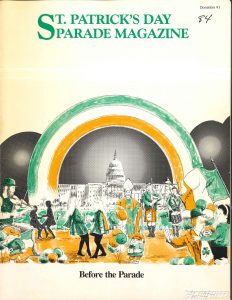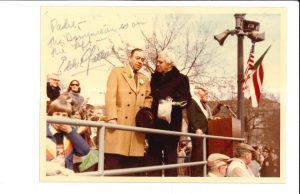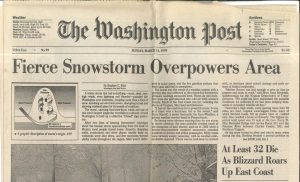
Speaking of rainbows, Father Hartke, and Mercedes McCambridge—who, coincidentally, was born on St. Patrick’s Day (McCambridge, 1981, p. 105)—the St. Patrick’s Day Parade [of] Washington, D.C. Collection now has an online finding aid. The collection contains particularly strong documentation of the first twenty-five or so years of the D.C. St. Patrick’s Day Parade—which has been held annually since 1971, traditionally on the Sunday before the holiday (March 17th). As such, Carole McNally points out that “The St. Patrick’s DAY Parade” is somewhat of a misnomer (1982, p. 19); a few times, however, such as on its twentieth anniversary in 1991, the parade has been celebrated on the actual holiday when March 17th happened to fall on a Sunday.
Although St. Patrick’s Day parades had been held in other large American cities (namely Boston) since the 1850s, D.C. was “a real latecomer” (“Twenty Five Years,” 1996, p. 6). Moreover, the timing of the first march, which roughly coincided with the onset of The Troubles in Northern Ireland (1968–1998), was regarded with suspicion by both the Metropolitan and Park Police. According to the histories that appear in the 1982 and 1987 Parade Magazines, the police feared that the marchers—whose original route went along Embassy Row, from Dupont Circle up Massachusetts Avenue—would end up demonstrating in front of the British Embassy (McNally, 1982, p. 18; McNally-McCarthy, 1987, p. 20). Their fears were not totally unfounded; in 1971, the marchers rallied at Robert Emmet Memorial Park, where there is a statue of the Irish patriot who was hanged in 1803 for leading an armed rebellion against British rule. In 1972, the marchers again strode from Dupont Circle to the Emmet statue; as Washington Post Staff Writer William R. MacKaye reported, the St. Patrick’s Day festivities “Lack[ed]” Their Usual Frivolity”; with the events of Bloody Sunday (January 30, 1972) barely past, the marchers bore placards decrying “British tyranny,” and demanding “Give Ireland back to the Irish” (MacKaye, 1972, D2).
Despite the tensions and political overtones of the early years, the parade has generally been billed as a “family day,” an “Irish community endeavor,” and “a day when people come together to enjoy the sharing of culture” (McNally-McCarthy, 1987, pp. 20–21). In 1974 the St. Patrick’s Day celebrants began parading down Constitution Avenue NW, along the Mall, between 7th and 17th Streets NW—the traditional route to this day. Regrettably, the collection does not include any materials pertaining to the 1974 parade (or the 2010 one for that matter). It was at this point that the parade grew larger and more sophisticated, incorporating floats and a reviewing stand (situated on the Ellipse, between the White House and the Washington Monument).

On two occasions the Grand Marshal has been a figure from The Catholic University of America. In 1982 it was the legendary founder of Catholic University’s Speech and Drama Department, the Reverend Gilbert V. Hartke—perhaps better known today as “the guy with the Dorothy dress.” In 2016 it was University President John Garvey. That year also marked the centenary of the 1916 Easter Rising. As it happens, this month marks the centennial of the end of the Irish War of Independence (1919–1921); a truce was declared on July 11, 1921.

Although for more than two decades the St. Patrick’s Day Parade Committee celebrated the fact that it had never rained on their parade (McNally-McCarthy, 1987, p. 21; Barry, 1991, p. 28), in 1993 the luck of the Irish ran out. On Sunday, March 14th, the front page headline of the Washington Post was “Fierce Snowstorm Overpowers Area.” A wintry mix of snow, sleet, rain, and hurricane-force winds pelted the capital region, causing the parade to be postponed until the next weekend. As Washington Post Staff Writer Serge F. Kovaleski reported, “The postponement took a toll on the annual event,” drawing only a fraction of the number of spectators as in previous years, featuring only 70 of the 110 units initially scheduled to participate, and lasting only an hour and a half instead of the usual two and a half. Worst of all, “the parade’s grand marshal, mystery writer Mary Higgins Clark […] was unable to make the snow date” (Kovaleski, 1993). But, as the saying goes, you can’t have a rainbow without a little rain. The following weekend brought “virtually perfect spring weather” and “savory 57-degree temperature[s]” (Kovaleski, 1993).
References
Barry, Carole McNally. (1991). “The St. Patrick’s Day Parade Story—A History of Sorts.” In Parade Magazine, pp. 28–29.
Kovaleski, Serge F. (1993, March 22). A Fine Day For the Wearin’ O’ the Green. Washington Post.
MacKaye, William F. (1972, March 18). St. Patrick’s Celebrations Lack Their Usual Frivolity. Washington Post, D2.
McCambridge, Mercedes. (1981). The Quality of Mercy. Times Books.
McNally, Carole. (1982). “Parades We Remember…” In Parade Magazine, pp. 18–19.
McNally-McCarthy, Carole. (1987). “1971–1987—The History of Our Parade.” In Parade Magazine, pp. 20–21.
“Twenty Five Years of Saint Patrick’s Day Parades.” (1996). Parade Magazine, pp. 6–8.
